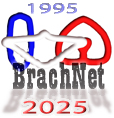 |
|
|||
| Family OBOLIDAE King, 1846
|
|---|
|
[Obolidae King, 1846, p. 28] [incl. Experilingulidae Ushatinskaya, 1992;Kyrshabaktellidae Holmer & Popov, herein, nom. correct. pro Kyrshabactellidae Ushatinskaya, 1992, p. 83]
Shell unequivalved or subequivalved, variable in outline; larval shell smooth; ventral pseudointerarea usually with deep pedicle groove; ventral propareas usually with well developed flexure lines; dorsal pseudointerarea variably developed; pedicle emerging between valves; muscle system with paired umbonal muscle a scars; dorsal visceral area b invariably with well-developed, tongue like, median, anterior projection; mantle canal system baculate with well-developed vascula media; ventral vascula lateralia usually divergent in posterior half or arcuate, converging anteriorly. c Lower Cambrian (upper Atdabanian)–Lower Carboniferous.
Diagnosis from volume 2 of the Treatise on Invertebrate Paleontology
Comments according to Emig (2002, 2003, 2006):
|
| Subfamily OBOLINAE King, 1846
|
|---|
| [nom. transl. Dall, 1870, p. 154, ex Obolidae King, 1846, p. 28] [incl. Lingulellinae SCHUCHERT, 1893]
Shell rounded, elongate, suboval to subtriangular, unequivalved; ventral pseudointerarea well developed, raised or continuous with valve floor; dorsal pseudointerarea with median groove or undivided. Lower Cambrian (upper Atdabanian)-Lower Carboniferous.
Diagnosis from volume 2 of the Treatise on Invertebrate Paleontology |
| NOTA : | Toutes diagnoses indiquées ici portent mention de la source utilisée dont il est obligatoire de citer la référence pour tout usage. |
| For all the diagnoses indicated herein, the original reference is given and must be cited for any use. |
|
|
|
How Lingulid Brachiopods made the USSR yield! Comment les Brachiopodes Lingulides ont fait céder l'URSS ! |
